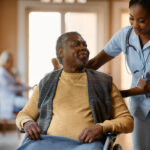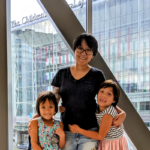
Now Enrolling: This myeloMATCH trial is testing a new treatment for patients with acute myeloid leukemia that has a FLT3-ITD or D835 mutation
July 2, 2024
Trial Results: How one patient’s role in an ECOG-ACRIN study for acute lymphocytic leukemia brought a cancer-free diagnosis and FDA approval
September 26, 2024Helping patients navigate their cancer diagnosis, treatment, clinical trial options, and more

Among the priorities of the Biden Administration’s ambitious Cancer Moonshot initiative is to increase patient access to navigation services. These services have been shown to improve the patient experience and treatment outcomes by helping patients and caregivers manage the many challenges that come with a cancer diagnosis. Navigation can also help to advance another national goal: including more people in clinical trials.
The concept of patient navigation is credited to cancer surgeon Dr. Harold Freeman. After completing his residency at Memorial Sloan-Kettering Cancer Center in the late 1960s, he began practicing medicine at Harlem Hospital Center only to find that the majority of patients arrived with cancer that was already advanced. He dedicated much of his distinguished career to developing model navigation programs to support more timely diagnosis and treatment for all patients—especially those traditionally underserved by the healthcare system.
Since that time, managing a cancer diagnosis has only gotten more complex for patients and their caregivers. Together, they face many challenges. They must learn to understand genetic and imaging test results, treatment regimens that are often complicated, and the complexities of insurance coverage. Finding clinical trials is very difficult. In addition, many people face significant transportation issues to receive treatment and must plan for extended follow-up care afterwards.
A 2022 survey of patients and survivors by the American Cancer Society Cancer Action Network found that while having access to patient navigation is overwhelmingly popular, only about half of respondents (53%) were familiar with the term “patient navigator”, and just 54% had encountered one.1
Paying for navigation has been an ongoing hurdle for healthcare providers to offer these services. However, that landscape saw a marked improvement earlier this year when the Centers for Medicare and Medicaid Services introduced reimbursement codes to support certain navigation services delivered by certified providers beginning in January 2024.
This move was quickly followed by an announcement in March by the Cancer Moonshot of commitments from leading health insurers and dozens of comprehensive cancer centers and community oncology practices to start using the new navigation codes. The aim is to extend these services to millions of Americans2:
“Navigators have been shown to improve health outcomes and the patient experience by reducing times between diagnosis and treatment and increasing treatment completion. These services also lower healthcare costs by reducing ER visits and hospitalizations and reduce health disparities, including by facilitating access to services to address unmet social determinants of health, such as food and housing insecurity and transportation needs.”
To get a better understanding of the important role of navigation in the cancer journey, staff at the ECOG-ACRIN Cancer Research Group spoke with Jennifer Tepper, APRN, Clinical Nurse Specialist and Breast Cancer Navigator based at Northwestern Medicine Cancer Center in Lake Forest, Illinois. Her hospital is in the network of the Robert H. Lurie Comprehensive Cancer Center at Northwestern University.
Tepper has practiced in oncology since 1989. She assumed her navigation role in 2006 with the launch of a navigation program at Lake Forest, working in tandem with their breast care center. At the time, there was no real infrastructure in place, so she and another full-time breast cancer navigator built the program from the ground up, with a focus on meeting with patients right after they are diagnosed to help explain their pathology and other test results and connect them with the right specialists. Chemotherapy teaching is another important aspect of her role as navigator, and the two breast navigators also manage and educate patients about the cold cap program to reduce chemotherapy-induced hair loss.
As the program has expanded, navigators provide other resources, including educational materials, referrals to social work and transportation support, nutrition, and eventually survivorship care plans, depending on the patient’s needs.
Getting patients to the right professionals is key, and depends on the diagnosis, Tepper explained, for example, if there is lymph node involvement, the patient is young, and/or the characteristics of their breast tumor. Tepper and her colleague work to explain it all to the patient, facilitate appointments with the right professionals, and will meet them at the time of the clinic visit as well.
“We are housed in the Cancer Center, so we work closely with the breast surgeons, medical oncology, radiation, and reconstructive surgeons. It’s much more conducive to helping patients, having all the specialists here with us.” She added that navigators try to be that consistent person all along to reinforce treatment decisions who patients can reach out to as their treatment evolves—also providing referrals to other practitioners who are available to support them, be it massage, nutrition, or coping resources through the social work department, for example.
Tepper added that she and the other navigators in her cancer center—currently a part-time lung cancer navigator, as well as a new navigator focused on immunotherapy—work alongside clinical trial nurses in the Northwestern network. Together, they support clinical research at their institution and connect potential clinical trial candidates to appropriate trials.
“Patients have a lot on their plate,” Tepper continued. “A big part of what we do that I’m proud of is that we don’t let people get lost; we guide and look out for them.”
1. https://www.fightcancer.org/policy-resources/survivor-views-copay-assistance-and-patient-navigation↩
2. https://www.whitehouse.gov/ostp/news-updates/2024/03/08/fact-sheet-biden-cancer-moonshot-announces-commitments-from-leading-health-insurers-and-oncology-providers-to-make-navigation-services-accessible-to-more-than-150-million-americans/↩

